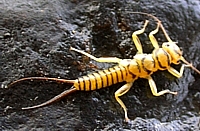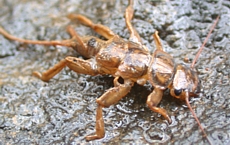|
|
ARTHROPODS:
Insects»
Spiders»
Centipedes»
Millipedes»
Sowbugs»
Harvestmen»
Mites
& Ticks»
Scorpions»
Identification
Tips»
About
the Critter Files»
Links» |
|
|
|
 |
STONEFLIES
Critter
Files/Insects/Stoneflies
By Blake Newton
University of Kentucky Department of Entomology |
| |
|
| Common
Kentucky Stoneflies: |
| |
| TAXONOMY |
KINGDOM: Animalia
| PHYLUM: Arthropoda | CLASS: Insecta | ORDER: Plecoptera (stoneflies) |
| |
WHAT
IS A STONEFLY?
LIFE CYCLE
ECOLOGY
PEST STATUS
COMMON KENTUCKY STONEFLIES
COLLECTING & PHOTOGRAPHY
STONEFLY FACTS
MYTHS, LEGENDS, AND FOLKLORE |
| |
| WHAT
IS A STONEFLY? |
|
| Adult stoneflies have
2 pairs of wings that are held flat over their bodies when they are
not flying. The front pair of wings is usually a little longer
than the back pair. Stoneflies also have 2 "tails"
(cerci) on the tips of their abdomens. Young stoneflies are
called "naiads," and they are fully aquatic. Naiads
are flattened and, like the adults, have 2 tails on the tips of their
abdomens, along with leafy gills at the bases of their legs. Both
adult stoneflies and naiads have chewing mouthparts, although the
mouthparts on many adult stoneflies are non-functional. Like
all insects, stoneflies have 6 legs, 3 body parts, and 2 antennae. |
|
| SIZE:
Most stonefly adults and naiads are ½" - 1" long.
|
| |
| LIFE
CYCLE |
|
Stoneflies
have incomplete metamorphosis: eggs are placed in masses on the
water surface by adult stoneflies and hatch into naiads. Naiads
may live underwater for a few years before moving to the water surface
to molt into winged adults. |
| |
 Stonefly
Naiad (B. Newton, 2004)
Stonefly
Naiad (B. Newton, 2004) |
 Stonefly
Naiad (B. Newton, 2004)
Stonefly
Naiad (B. Newton, 2004) |
| |
| ECOLOGY |
|
Stonefly
naiads occur in fast moving streams where they are most commonly
found clinging to the undersides of rocks. Many stonefly naiads
are predators, feeding on other aquatic arthropods. Naiads
of other species eat plants and algae. Although stonefly naiads
were once very common in streams, they are very sensitive to pollution.
These days, stonefly naiads are only common in very clean
water. Stonefly adults can't fly very well, and are usually
found sitting on rocks near the streams where they emerged. Many
stonefly adults do not feed, others feed on algae, pollen, or other
plant parts. Stoneflies are a very important food source for
fish and birds, and they are also eaten by spiders and predatory
insects. |
| |
| PEST
STATUS |
|
Stoneflies
are not considered pests.
|
| |
| COLLECTING
& PHOTOGRAPHY |
|
Adult stoneflies usually
emerge from the water at very specific times of the year. Depending
on the species, they are very common at certain times of the year,
impossible to find at others. Many common species emerge in
the late-spring and early summer, and they are most active at night.
Look for them near fast-flowing streams and lakes. Stonefly
naiads, on the other hand, can be found at almost any time of the
year in clean, clear streams. Stonefly naiads, like all naiads,
should be preserved in alcohol.
Unlike some other aquatic
insects, stonefly naiads usually do not do well in home aquariums.
Most stoneflies need running water with lots of oxygen - a
condition that is difficult to maintain in an aquarium. |
| |
| STONEFLY
FACTS |
|
Like many aquatic insects,
stonefly naiads need clean water to live. Because of this,
scientists can tell if a stream is polluted or not based on whether
stonefly naiads are present. Read more about using insects
to determine water quality: http://www.aces.edu/pubs/docs/A/ANR-1167/ANR-1167.pdf
|
| |
| MYTHS
- LEGENDS - FOLKLORE |
|
Have you heard any
myths, legends, or folklore about stoneflies? If so, let us
know.
|
Original document: 25 May 2004
Last updated: 25 May 2004
Photos courtesy R. Bessin and B. Newton, University of Kentucky
The Kentucky Critter
Files are maintained by Blake Newton, Department of Entomology, University
of Kentucky.
Contact: blaken@uky.edu
|
|

